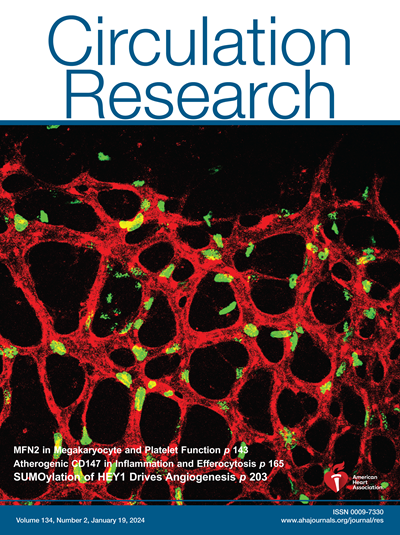CCL21 Enhances Platelet Activation and Atherothrombosis via CCR7 Activation.
IF 16.2
1区 医学
Q1 CARDIAC & CARDIOVASCULAR SYSTEMS
引用次数: 0
Abstract
BACKGROUND The homeostatic chemokine CCL21 (C-C motif chemokine ligand 21) is abnormally elevated in coronary artery disease. Plasma CCL21 levels have been found to be independently associated with adverse outcomes after acute coronary syndrome. However, the specific effects of CCL21 on coronary artery disease-associated platelet activation and thrombosis remain poorly understood. METHODS We examined the effects of CCL21 on platelet activation, spreading, clot retraction, in vitro shear stress-induced thrombus formation, in vivo arterial thrombus formation, middle cerebral artery occlusion-induced brain injury, and myocardial ischemia-reperfusion injury. We also investigated the underlying mechanisms and the therapeutic impacts of a CCL21 antibody on platelet activation and in vivo thrombosis in atherosclerosis. RESULTS CCL21 potentiated agonist-induced platelet activation, including aggregation, dense granule release, P-selectin exposure, integrin αIIbβ3 activation, spreading, and clot retraction. Furthermore, CCL21 enhanced in vivo thrombosis, whole blood thrombus formation, and middle cerebral artery occlusion-induced brain injury. Mechanistically, CCL21 binds to platelet CCR7 (C-C motif chemokine receptor 7), a G-protein-coupled receptor previously unreported in platelets, activating Gi and G13 signaling pathways to enhance platelet activation. A CCL21 antibody attenuated platelet activation and inhibited in vivo thrombosis in patients with coronary artery disease and atherosclerotic ApoE-/- mice. In addition, this antibody mitigated microvascular thrombosis, safeguarding the hearts of atherosclerotic ApoE-/- mice from severe ischemia-reperfusion injury. CONCLUSIONS CCL21 enhances platelet activation and atherothrombosis by binding to platelet CCR7 and thus activating downstream Gi and G13 signaling pathways. A CCL21 antibody can counteract these effects in the context of coronary artery disease, supporting its potential as a preventive therapy for thrombotic complications.ccr21通过CCR7激活增强血小板活化和动脉粥样硬化血栓形成。
稳态趋化因子CCL21 (C-C基序趋化因子配体21)在冠状动脉疾病中异常升高。血浆CCL21水平已被发现与急性冠状动脉综合征后的不良结局独立相关。然而,CCL21对冠状动脉疾病相关血小板活化和血栓形成的具体作用仍知之甚少。方法观察CCL21对血小板活化、扩散、凝块缩回、体外剪应力诱导血栓形成、体内动脉血栓形成、大脑中动脉闭塞性脑损伤、心肌缺血再灌注损伤的影响。我们还研究了CCL21抗体对动脉粥样硬化患者血小板活化和体内血栓形成的潜在机制和治疗作用。结果sccl21可增强激动剂诱导的血小板活化,包括聚集、致密颗粒释放、p选择素暴露、整合素α ib β3活化、扩散和凝块收缩。此外,CCL21还能增强体内血栓形成、全血血栓形成和大脑中动脉闭塞性脑损伤。从机制上讲,CCL21结合血小板CCR7 (C-C motif趋化因子受体7),这是一种在血小板中未报道的g蛋白偶联受体,激活Gi和G13信号通路,增强血小板活化。CCL21抗体可减弱冠心病患者和动脉粥样硬化ApoE-/-小鼠的血小板活化并抑制体内血栓形成。此外,该抗体可减轻微血管血栓形成,保护动脉粥样硬化ApoE-/-小鼠心脏免受严重缺血再灌注损伤。结论sccl21通过与血小板CCR7结合,激活下游Gi和G13信号通路,从而增强血小板活化和动脉粥样硬化血栓形成。在冠状动脉疾病的情况下,CCL21抗体可以抵消这些作用,支持其作为血栓性并发症的预防性治疗的潜力。
本文章由计算机程序翻译,如有差异,请以英文原文为准。
求助全文
约1分钟内获得全文
求助全文
来源期刊

Circulation research
医学-外周血管病
CiteScore
29.60
自引率
2.00%
发文量
535
审稿时长
3-6 weeks
期刊介绍:
Circulation Research is a peer-reviewed journal that serves as a forum for the highest quality research in basic cardiovascular biology. The journal publishes studies that utilize state-of-the-art approaches to investigate mechanisms of human disease, as well as translational and clinical research that provide fundamental insights into the basis of disease and the mechanism of therapies.
Circulation Research has a broad audience that includes clinical and academic cardiologists, basic cardiovascular scientists, physiologists, cellular and molecular biologists, and cardiovascular pharmacologists. The journal aims to advance the understanding of cardiovascular biology and disease by disseminating cutting-edge research to these diverse communities.
In terms of indexing, Circulation Research is included in several prominent scientific databases, including BIOSIS, CAB Abstracts, Chemical Abstracts, Current Contents, EMBASE, and MEDLINE. This ensures that the journal's articles are easily discoverable and accessible to researchers in the field.
Overall, Circulation Research is a reputable publication that attracts high-quality research and provides a platform for the dissemination of important findings in basic cardiovascular biology and its translational and clinical applications.
 求助内容:
求助内容: 应助结果提醒方式:
应助结果提醒方式:


